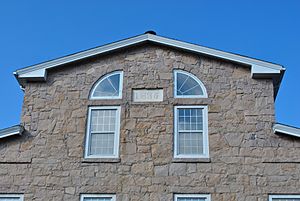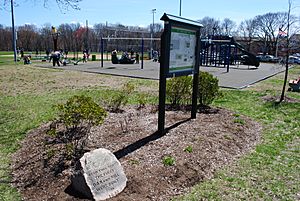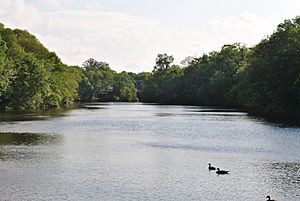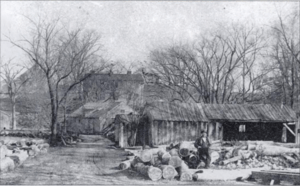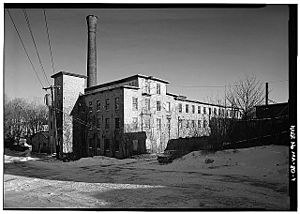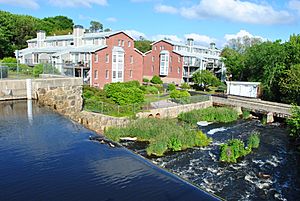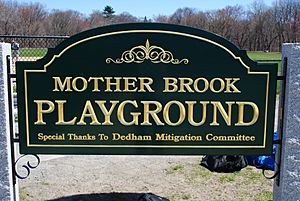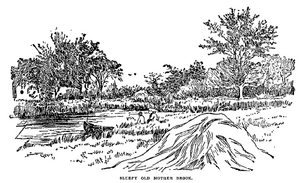Mother Brook facts for kids
Quick facts for kids Mother Brook |
|
|---|---|
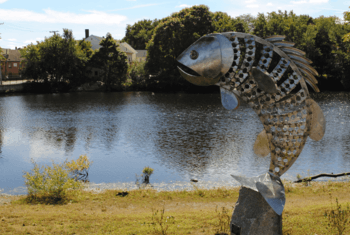
A sculpture at Mill Pond Park along the banks of Mother Brook.
|
|
| Country | United States |
| State | Massachusetts |
| Physical characteristics | |
| Main source | Charles River Dedham, Massachusetts 97 ft (30 m)approximate using MapMyRun 42°15′18″N 71°09′53″W / 42.25500°N 71.16472°WLocation of the USGS Hydrologic Unit, .4 mi downstream from diversion from Charles River. |
| River mouth | Neponset River Hyde Park, Massachusetts 55 ft (17 m)approximate using MapMyRun 42°15′08″N 71°07′23″W / 42.25222°N 71.12306°W |
| Length | 3.6 mi (5.8 km)approximate using MapMyRun |
| Discharge (location 2) |
|
Mother Brook is a stream that flows from the Charles River in Dedham, Massachusetts, to the Neponset River in the Hyde Park section of Boston, Massachusetts. In earlier times, it was also known as East Brook or Mill Creek.
This brook is special because it was dug by English settlers in 1639. It is the first human-made canal in the United States. Mother Brook was very important to Dedham. It was the only source of water power for mills from 1639 until the early 1900s.
Today, Mother Brook helps control floods. It moves water from the Charles River to the Neponset River. The Massachusetts Department of Conservation and Recreation manages the brook's flow. There are three dams and a movable floodgate that controls water from the Charles into Mother Brook.
The brook's name lives on in groups like the Mother Brook Community Group and the Mother Brook Arts and Community Center.
Contents
Early History of Mother Brook
Why the Brook Was Built
Dedham, Massachusetts was settled in 1635. The early settlers needed a mill to grind their corn. Hand mills took too much effort. Windmills were not reliable enough. The closest watermill was far away in Watertown.
The Charles River near Dedham was slow-moving. It did not have enough drop in height to power a water wheel. A small stream, then called East Brook, ran nearby. It had a good drop in height (over 40 feet) but not enough water.
So, in 1639, the town came up with a bold plan. They decided to dig a ditch to connect the Charles River to East Brook. This would bring plenty of water from the Charles into East Brook. The town paid for the ditch, and settlers were taxed to help. It is believed that Nathaniel Whiting helped dig it. Water was flowing through the ditch by July 14, 1641. Since at least 1678, it has been known as Mother Brook.
First Mills on the Brook
The town offered land to anyone who would build and keep a corn mill. The first corn mill was built in 1641 by John Elderkin. It was located near what is now Condon Park. This was the first public utility in the nation. Settlers could grind their corn and pay a small fee to help maintain the mill.
Nathaniel Whiting later became the sole owner of this first mill. He and his family ran it for many generations until 1823. Over time, more mills were built along Mother Brook. These included mills for fulling wool (making it thicker) and even a leather mill.
Mother Brook's Industrial Growth
Over the years, many dams and mills were built along Mother Brook. These were located in Dedham and in the Readville area of Hyde Park. Mother Brook provided power for many types of factories. These included mills for cotton, wool, paper, and wire. They also ground corn, sawed lumber, and made nails. Mills operated on Mother Brook until the 1900s.
The growth of these industries led to more houses being built for workers. Churches, shops, and other businesses also grew in the area. The East Dedham Firehouse, built in 1855, is still in use today.
1800s: A Time of Change
In the 1800s, mills began making goods for people beyond Dedham. They became very profitable. The factories, dye houses, and homes around just one mill were like a "little village."
The mills attracted immigrants from Europe and Canada. Many Irish families came after the Great Famine in the 1840s. Germans followed in the 1850s, and Italians later. Many workers stayed for a short time before moving on.
Some mill owners built houses for their workers. For example, Benjamin Bussey built boarding houses. In 1829, men paid $1.50 per week for room and board, and women paid $1.25.
The Second Mill Site
The leather mill at the second privilege was replaced in 1807. A large wooden mill called the Norfolk Cotton Manufactory was built there. This mill spun imported cotton. The fabric was then sent out to be woven. People were proud to have a cotton factory in their town.
However, the War of 1812 hurt the company. Cheap imports flooded the market. Benjamin Bussey bought the mill in 1819 for a low price.
The Fourth Mill Site
The fourth mill site was used for many things in the 1800s. It made copper cents, paper, cotton, and wool. In the 1780s, a mill there made wire for the new nation's textile industry.
The first mill on this site burned in 1809 but was rebuilt. In 1814, a second mill began making nails. In 1835, a new stone mill was built. This stone mill still stands today. It was turned into apartments (condominiums) in 1986–87. This factory had a special stone with "1835" on it and a dome-roofed tower for a mill bell.
The mill at the fourth site was one of the first to use water-powered looms. These machines could take raw wool, spin it into thread, and weave it into finished fabric all in one place.
The Fifth Mill Site
In 1814, a fifth mill site was created in what is now Readville. The Dedham Manufacturing Company built a mill there. James Read, one of the owners, gave his name to the Readville neighborhood.
Water Disputes with Other Towns
As Dedham's industries grew, other towns along the Charles River also used its water. This led to arguments. As early as 1767, mill owners in Newton and Watertown complained. They said that Mother Brook was taking too much water from the Charles River.
One person in 1895 called it "the most audacious attempt of robbery." They said Dedham was trying to "steal the river Charles."
Mill owners on the Neponset River sided with the Mother Brook owners. This was because more water flowing into Mother Brook meant more water for their mills downstream on the Neponset. After many court battles and agreements, it was finally decided in 1831 that one-third of the Charles River's water would go into Mother Brook. The other two-thirds would stay in the Charles. This agreement is still in effect today.
Mother Brook in the 1900s
In the early 1900s, Mother Brook was still very important for Dedham's businesses. However, the mills began to close as the textile industry declined. By the 1980s, most of the old cotton mills and factories were gone.
In the 1960s, the land at the fifth mill site was bought by the Department of Conservation and Recreation. They cleaned up the area and planned for boating and hiking. When the Dedham Mall was built, part of the brook was put into underground pipes.
The old sill (a barrier to control water flow) at the mouth of the brook was replaced. Now, there is a mechanical floodgate that can be raised or lowered. This helps control water levels in the Charles River.
Pollution and Cleanups
After hundreds of years of industrial use, Mother Brook became very polluted. Factories dumped waste into the water. Gasoline, chemicals, and even raw sewage were found in the brook. For example, in 1975, a large oil spill was found. A company was fined for dumping chemicals like trichloroethylene from 1986 to 1994.
In the 1990s, a science teacher and her students from Dedham High School tested the water. They found that the water quality was good, but it was not safe for full body contact. While there has been much progress, Mother Brook was still one of the most polluted parts of the Neponset River watershed in 2017.
Many groups have organized cleanups in recent years. In 2007, part of the brook was redirected to clean up PCBs (a type of chemical). In 2017, plans were made to remove trees and plants near the Charles River to protect the dam.
Historic Recognition
In the 2010s, the Mother Brook Community Group started a project. They wanted Mother Brook to be listed on the National Register of Historic Places. This would recognize its important history. A study found over 70 buildings and structures related to the mills still standing. These include:
- The Merchant Woolen Company's Factory Mill Number 2, built around 1855.
- Private homes on Maverick and High Streets that were built as boarding houses for mill workers.
- Brookdale Cemetery, which grew to serve the larger population that moved to town for mill jobs.
This research was sent to the Massachusetts Historical Commission. They will decide if Mother Brook qualifies for the National Register.
Floods Along the Brook
Mother Brook has flooded many times throughout history. In 1886, the water flooded its banks. There were fears that dams would break. It was one of the biggest floods Dedham Center had ever seen.
In March 1936, streets in Dedham had water two to three feet deep. Rain and melting snow caused floods in 1948. In 1955, ice chunks at the dams caused flooding. Firefighters had to spray high-pressure water to break the ice.
Later in 1955, during major floods in New England, 150 people in Hyde Park had to leave their homes. Roads in Dedham were also flooded. The state approved millions of dollars for flood control in Mother Brook and the Neponset River.
In March 1958, 120 men used 1,200 sandbags to prevent flooding in Hyde Park. In 1968, hundreds of residents along the Charles, Neponset, and Mother Brook had to be evacuated.
The 1938 Flood
In 1938, while other rivers were flooding, the area around Mother Brook was mostly safe at first. The dams helped control the heavy water flow. However, many homes in low-lying areas eventually had flooded basements. The wooden bridge at Maverick Street was threatened. Sandbags and granite slabs were used to keep it from washing away.
During this flood, three young men tried to canoe down the Charles River. Their canoe flipped, and they were swept down Mother Brook. They were saved when a rescuer threw them a garden hose.
Mills on Mother Brook
First Mill Site
The first mill site was located near what is now Condon Park.
| Year | Owner | Product | Notes | Image |
|---|---|---|---|---|
| 1641 | John Elderkin | Corn | First mill built on Mother Brook. | |
| 1642 | Nathaniel Whiting and others | Corn | ||
| 1649 | Nathaniel Whiting | Corn | ||
| 1821 | Dedham Worsted Company | Worsted | ||
| 1824 | Benjamin Bussey | Wool | Bussey built workshops, dye houses, and homes for workers. | |
| 1843 | Maverick Woolen Company | Wool | ||
| 1863 | Merchants Woolen Company | Wool | ||
| 1909 | Hodge's Finishing Company | Bleach and Finish Cotton Pieces; Metal and Rubber Faced Type | Employed 50 people, produced 35,000 yards per day. | |
| 1938 - Present Day | Condon Park | N/A | The factory closed, and Condon Park was built over its foundation. |
Second Mill Site
The second mill site was located at what is now Maverick Street.
| Year | Owner | Product | Notes | Image |
|---|---|---|---|---|
| 1664 | Ezra Morse | Corn | Mill removed in 1699. | |
| Early 1700s | Joseph Lewis | Leather | ||
| 1807 | Norfolk Cotton Manufactory | Cotton | This company was hurt by the War of 1812. | |
| 1819 | Benjamin Bussey | Wool | This mill and the first mill were owned by Bussey after 1824. | |
| 1843 | Maverick Woolen Company | Wool | ||
| 1863 | Merchants Woolen Company | Wool | ||
| 1936 | Boston Envelope Company | Envelopes | Could produce 800,000 envelopes a day. | |
| Present Day | AliMed | Medical products and supplies |
Third Mill Site
The third mill site was located at what is now Saw Mill Lane.
| Year | Owner | Product | Notes | Image |
|---|---|---|---|---|
| 1682 | Nathaniel Whiting and James Draper | Fulling | Whiting's family owned this mill for over 180 years. | |
| 1863 | Edmunds and Colby | |||
| 1864 | Thomas Barrows | |||
| 1872 | Merchants Woolen Company | |||
| 1883 | Merchants Woolen Company | Saw and grist mill | When this mill closed, it was the first time in 240 years there was no grist mill on Mother Brook. | |
| 1894 | J. Eugene Cochrane | N/A | This mill closed and merged with the fourth mill site. | |
| Present day | Strip mall and Dunkin Donuts |
Fourth Mill Site
The fourth mill site's first mill was located at what is now Stone Mill Drive.
| Year | Owner | Product | Notes | Image |
|---|---|---|---|---|
| 1787 | Joseph Whiting, Jr., Paul Moses, Aaron Whiting | Copper cents | ||
| ~1790 | Hermann Mann | Paper | ||
| 1804 | George Bird | Paper | Burned down and rebuilt in 1809. | |
| 1823 | George Bird and Frederick A. Taft | Cotton | Taft was an experienced cotton maker. | |
| 1835 | Norfolk Manufacturing Company | Cotton | A new stone mill was built here. It was made of Dedham Granite. | |
| 1863 | Thomas Barrows | Wool | Barrows made the mill bigger and added turbines and a steam engine. | |
| 1872 | Merchants Woolen Company | Wool | ||
| 1894 | J. Eugene Cochrane | Carpets and handkerchiefs | This mill and the third mill site were owned together. | |
| After 1917 | Closed | |||
| Before 1927 | United Waste Company | Wool, reclaimed fabric, and cloth recycling | This was the last industrial use of the property. | |
| 1986 | Bergmeyer Development Co. | Re-purposed for 86 condominiums | The purchase price was $1.6 million. | |
| Present day | Stone Mill Condominiums |
The fourth mill site's second mill was also located at Stone Mill Drive.
| Year | Owner | Product | Notes | Image |
|---|---|---|---|---|
| ~1787 | Ruggles Whiting | Wire | ||
| 1814 | Ruggles Whiting | Nails | ||
| 1819 | George Bird | Paper | Bird already owned the first mill at this site. |
Fifth Mill Site
The fifth mill site was located at the corner of Knight St. and River St. in Readville.
| Year | Owner | Product | Notes | Image |
|---|---|---|---|---|
| 1814 | Dedham Manufacturing Company | Cotton | The first buildings were made of wood. | |
| 1875 | Smithfield Manufacturing Company | Cotton | They built brick mills. | |
| 1879 | B.B. & R. Knight Cotton | Cotton | They rebuilt the dam and made other improvements. | |
| 1922 | Francis W. Smith | The main building was brick, 331 feet long. | ||
| Present day | Part of Stony Brook Reservation |
Bridges Over Mother Brook
After leaving the Charles River, Mother Brook immediately flows under a bridge on Providence Highway. A tablet was placed on this bridge to remember the brook. It then goes under a culvert at the Dedham Mall. The brook reappears near the transfer station and flows to the Washington Street Bridge.
It also crosses under Maverick Street, Bussey Street, and Saw Mill Lane. These are all sites of old mills. Inside the Mother Brook Condominium complex, the brook runs under a small bridge. After entering Hyde Park, it goes under bridges at River Street and Reservation Road. Finally, it joins the Neponset River.
Many groups, including the state, towns, and private owners, have worked to improve these bridges over the years.
Recreation on Mother Brook
In 1893, a canoeist described a trip down the brook. He wrote about leaving the wide Charles River for the narrow brook. He saw barnyards, ducks, and then cool woodlands. The water was shallow and clear, with colorful pebbles and small fish. He noted it was a busy stream, powering many mills.
Mother Brook was once a popular place for swimming and ice skating. A public bath house was built in 1898. In 1907, Tuesdays and Fridays were set aside for women to swim. Girls under 16 could swim for free. The bath house burned down in 1923. In the winters of the 1870s and 1880s, hundreds of young people would ice skate on the brook.
Louis D. Brandeis, who later became a Supreme Court justice, suggested including the brook in the Metropolitan Park System of Greater Boston in 1905. He thought it was unique and beautiful. However, mill owners threatened to sue, and it was too expensive to add it then.
In 1915, well-kept gardens lined both sides of the brook. It was also popular for boating and bathing. In the 1930s and 1940s, the state stocked the brook with trout for fishing. Many fishermen lined the banks in 1941.
Today, there are walking trails, picnic areas, and a canoe launch along the brook. Condon Park has a playground that is accessible for people with disabilities. The Mother Brook Community Group helped create Mill Pond Park, which opened in 2014. They also made more areas of the brook open for fishing. The fish caught are safe to eat in small amounts. In 2015, a committee was formed to celebrate Mother Brook's 375th anniversary.
|





